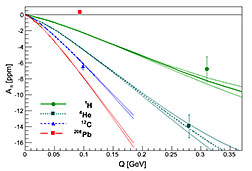- Number 389 |
- May 27, 2013
Experimental check yields surprising new result

This graph shows the predicted values
(colored lines) and measured values
(colored points) for the nuclei of hydrogen,
helium, carbon and lead. Note that the points
lie close to the lines for all of the nuclei
except lead. It's thought that this surprising
result is due to energetic electrons interacting
more profusely with nuclei that contain more
protons than those with fewer, a phenomenon
that was known but was not expected to play
a role in this measurement.
A routine experimental check has revealed that energetic electrons may interact more profusely with nuclei that contain more protons than those with fewer. Though not completely unexpected, the researchers were surprised to find evidence of the effect in this experimental check. The result comes from explorations of the lead nucleus conducted at DOE's Jefferson Lab, and it could provide insight into heavy matter.
The scientists got the result from experiments that consisted of banging spinning electrons into various nuclei and observing the aftermath.
According to Robert Michaels, a Jefferson Lab nuclear physicist in Experimental Hall A, the spin of the electrons must be precisely aligned in the preferred direction for the measurements to be successful. That's because the scientists are getting their information from the tiny differences, called asymmetries, that the experiments provide when they flip the spin of the electrons from one direction to its opposite and compare the results. If the spin of the electrons are not precisely aligned along the direction of interest, then these asymmetries are not entirely due to the phenomenon that is being measured.
For two experiments - HAPPEx and PREX - scientists were measuring the asymmetries for electrons that spin along the direction of travel of the electrons and opposite the direction of travel. (This asymmetry measurement provides a direct probe of the weak interaction.)
"We were worried that the beam had its spins slightly tilted. When you flip the spin you get an asymmetry which might be large and have nothing to do with the weak-interaction effect that we were trying to isolate," Michaels says.
If the spin direction of the electrons is tilted in the up/down direction, then the asymmetry that the scientists measure could be polluted with another effect. An asymmetry between the up/down spin directions measures an effect called two-photon exchange. When experimenters probe nuclei with electrons, the electrons most often interact with protons in the nuclei by exchanging a discrete parcel of energy that physicists call a virtual photon. However, sometimes the electrons may exchange two discrete parcels of energy, or two virtual photons.
With so much of the experiment's viability resting on this one detail, the scientists have developed safeguards. They measure the along/opposite asymmetries that they are primarily interested in, as well as the up/down asymmetries as a check to make sure they can correct for any tilt of the beam.
The scientists probed a variety of nuclei, including hydrogen and helium for the HAPPEx experiment, and carbon and lead for the PREX experiment. Of these, most have very few protons in their nucleus, such as hydrogen (one proton), helium (two protons) and carbon (six protons). These are called light nuclei. The last nucleus, lead, contains 82 protons, and it is considered to be a heavy nucleus.
"There's a theory to predict what you should see. And the theory worked well for the hydrogen, the helium and the carbon. So for the relatively light nuclei, it worked out," Michaels says.
The scientists found that in the light nuclei, they measured an increasing up/down asymmetry with an increasing number of protons in the nucleus. For instance, carbon had the highest number of two-photon exchanges, the helium had fewer and hydrogen had the fewest.
But the result that the researchers got for the heaviest nucleus they measured, lead, was a complete surprise. In lead, the up/down asymmetry turned out to be zero. Simplistically speaking, this indicated that there were no two-photon exchanges taking place.
The scientists suspect what really happened is that their measurement of two-photon exchange may have been overwhelmed by a different phenomenon.
"Now, we suspect some reasons as to why it may happen, and there is probably some reasonable explanation, having to do with Coulomb distortions, but nobody's calculated it yet," Michaels says.
According to Charles Horowitz, a theorist at Indiana University, the culprit for the different lead measurement may be due to the abundance of protons in the lead nucleus.
"In a lighter nucleus like carbon with only six protons, the electron only scatters with a few protons, and the probability to scatter more is very small. But with lead, since there are all these protons in the nucleus, the probability to scatter from lots of protons is big, and that apparently is giving you this very different result," Horowitz explains.
It's thought that because lead contains so many protons, the electrons may have interacted with not one, but many of the protons as they traveled through the nucleus. Since the electron is far more likely to interact with a proton by exchanging a single photon, these many single-photon interactions may be overwhelming the small number of two-photon interactions.
Michaels and Horowitz say that this phenomenon of multiple interactions has not yet been calculated and added to the theory used to describe such experiments.
"The next step is to work on those calculations, but it's also to measure this scattering from nuclei with charges in between carbon and lead – so, a nucleus such as calcium with 20 protons, which is in between the six in carbon and the 82 in lead," Horowitz says.
It's hoped that the addition of the theory calculations, as well as future experiments at other facilities, such as Mainz, may help to disentangle the result.
The result was published in Physical Review Letters.[Kandice Carter, 757.269.7263,
kcarter@jlab.org]
